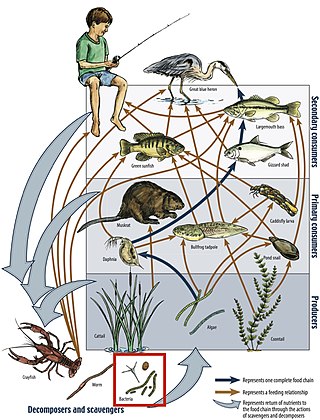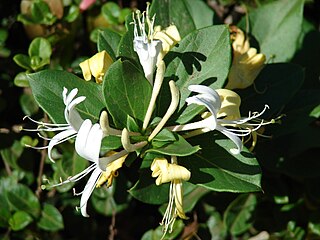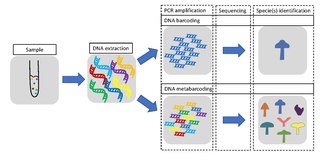A complex system is a system composed of many components which may interact with each other. Examples of complex systems are Earth's global climate, organisms, the human brain, infrastructure such as power grid, transportation or communication systems, complex software and electronic systems, social and economic organizations, an ecosystem, a living cell, and, ultimately, for some authors, the entire universe.

Mutualism describes the ecological interaction between two or more species where each species has a net benefit. Mutualism is a common type of ecological interaction, one that can come from a parasitic interaction. Prominent examples include most vascular plants engaged in mutualistic interactions with mycorrhizal fungi, flowering plants being pollinated by animals, vascular plants being dispersed by animals, and corals with zooxanthellae, among many others. Mutualism can be contrasted with interspecific competition, in which each species experiences reduced fitness, and exploitation, or parasitism, in which one species benefits at the expense of the other.

A pollinator is an animal that moves pollen from the male anther of a flower to the female stigma of a flower. This helps to bring about fertilization of the ovules in the flower by the male gametes from the pollen grains.

A food web is the natural interconnection of food chains and a graphical representation of what-eats-what in an ecological community. Ecologists can broadly define all life forms as either autotrophs or heterotrophs, based on their trophic levels, the position that they occupy in the food web. To maintain their bodies, grow, develop, and to reproduce, autotrophs produce organic matter from inorganic substances, including both minerals and gases such as carbon dioxide. These chemical reactions require energy, which mainly comes from the Sun and largely by photosynthesis, although a very small amount comes from bioelectrogenesis in wetlands, and mineral electron donors in hydrothermal vents and hot springs. These trophic levels are not binary, but form a gradient that includes complete autotrophs, which obtain their sole source of carbon from the atmosphere, mixotrophs, which are autotrophic organisms that partially obtain organic matter from sources other than the atmosphere, and complete heterotrophs that must feed to obtain organic matter.

Pollination is the transfer of pollen from an anther of a plant to the stigma of a plant, later enabling fertilisation and the production of seeds. Pollinating agents can be animals such as insects, for example beetles or butterflies; birds, and bats; water; wind; and even plants themselves. Pollinating animals travel from plant to plant carrying pollen on their bodies in a vital interaction that allows the transfer of genetic material critical to the reproductive system of most flowering plants. When self-pollination occurs within a closed flower. Pollination often occurs within a species. When pollination occurs between species, it can produce hybrid offspring in nature and in plant breeding work.

In ecology, a biological interaction is the effect that a pair of organisms living together in a community have on each other. They can be either of the same species, or of different species. These effects may be short-term, or long-term, both often strongly influence the adaptation and evolution of the species involved. Biological interactions range from mutualism, beneficial to both partners, to competition, harmful to both partners. Interactions can be direct when physical contact is established or indirect, through intermediaries such as shared resources, territories, ecological services, metabolic waste, toxins or growth inhibitors. This type of relationship can be shown by net effect based on individual effects on both organisms arising out of relationship.

Pollinator decline is the reduction in abundance of insect and other animal pollinators in many ecosystems worldwide that began being recorded at the end of the 20th century. Multiple lines of evidence exist for the reduction of wild pollinator populations at the regional level, especially within Europe and North America. Similar findings from studies in South America, China and Japan make it reasonable to suggest that declines are occurring around the globe. The majority of studies focus on bees, particularly honeybee and bumblebee species, with a smaller number involving hoverflies and lepidopterans.

The lychnis is a moth of the family Noctuidae. It is found in northern and western Europe and Turkey. It has an Atlantic-Mediterranean distribution. In the East Palearctic it is replaced by Hadena capsincola.
Nestedness is a measure of structure in an ecological system, usually applied to species-sites systems, or species-species interaction networks.

Ornithophily or bird pollination is the pollination of flowering plants by birds. This sometimes coevolutionary association is derived from insect pollination (entomophily) and is particularly well developed in some parts of the world, especially in the tropics, Southern Africa, and on some island chains. The association involves several distinctive plant adaptations forming a "pollination syndrome". The plants typically have colourful, often red, flowers with long tubular structures holding ample nectar and orientations of the stamen and stigma that ensure contact with the pollinator. Birds involved in ornithophily tend to be specialist nectarivores with brushy tongues and long bills, that are either capable of hovering flight or light enough to perch on the flower structures.
An ecological network is a representation of the biotic interactions in an ecosystem, in which species (nodes) are connected by pairwise interactions (links). These interactions can be trophic or symbiotic. Ecological networks are used to describe and compare the structures of real ecosystems, while network models are used to investigate the effects of network structure on properties such as ecosystem stability.

A biological network is a method of representing systems as complex sets of binary interactions or relations between various biological entities. In general, networks or graphs are used to capture relationships between entities or objects. A typical graphing representation consists of a set of nodes connected by edges.
In ecology, a priority effect refers to the impact that a particular species can have on community development as a result of its prior arrival at a site. There are two basic types of priority effects: inhibitory and facilitative. An inhibitory priority effect occurs when a species that arrives first at a site negatively affects a species that arrives later by reducing the availability of space or resources. In contrast, a facilitative priority effect occurs when a species that arrives first at a site alters abiotic or biotic conditions in ways that positively affect a species that arrives later. Inhibitory priority effects have been documented more frequently than facilitative priority effects. Studies indicate that both abiotic and biotic factors can affect the strength of priority effects. Priority effects are a central and pervasive element of ecological community development that have significant implications for natural systems and ecological restoration efforts.
Consumer–resource interactions are the core motif of ecological food chains or food webs, and are an umbrella term for a variety of more specialized types of biological species interactions including prey-predator, host-parasite, plant-herbivore and victim-exploiter systems. These kinds of interactions have been studied and modeled by population ecologists for nearly a century. Species at the bottom of the food chain, such as algae and other autotrophs, consume non-biological resources, such as minerals and nutrients of various kinds, and they derive their energy from light (photons) or chemical sources. Species higher up in the food chain survive by consuming other species and can be classified by what they eat and how they obtain or find their food.

Evolving digital ecological networks are webs of interacting, self-replicating, and evolving computer programs that experience the same major ecological interactions as biological organisms. Despite being computational, these programs evolve quickly in an open-ended way, and starting from only one or two ancestral organisms, the formation of ecological networks can be observed in real-time by tracking interactions between the constantly evolving organism phenotypes. These phenotypes may be defined by combinations of logical computations that digital organisms perform and by expressed behaviors that have evolved. The types and outcomes of interactions between phenotypes are determined by task overlap for logic-defined phenotypes and by responses to encounters in the case of behavioral phenotypes. Biologists use these evolving networks to study active and fundamental topics within evolutionary ecology.
Flowering synchrony is the amount of overlap between flowering periods of plants in their mating season compared to what would be expected to occur randomly under given environmental conditions. A population which is flowering synchronously has more plants flowering at the same time than would be expected to occur randomly. A population which is flowering asynchronously has fewer plants flowering at the same time than would be expected randomly. Flowering synchrony can describe synchrony of flowering periods within a year, across years, and across species in a community. There are fitness benefits and disadvantages to synchronized flowering, and it is a widespread phenomenon across pollination syndromes.

Floral scent, or flower scent, is composed of all the volatile organic compounds (VOCs), or aroma compounds, emitted by floral tissue. Other names for floral scent include, aroma, fragrance, floral odour or perfume. Flower scent of most flowering plant species encompasses a diversity of VOCs, sometimes up to several hundred different compounds. The primary functions of floral scent are to deter herbivores and especially folivorous insects, and to attract pollinators. Floral scent is one of the most important communication channels mediating plant-pollinator interactions, along with visual cues.

Pedro Diego Jordano Barbudo is an ecologist, conservationist, researcher, focused on evolutionary ecology and ecological interactions. He is an honorary professor and associate professor at University of Sevilla, Spain. Most of his fieldwork is done in Parque Natural de las Sierras de Cazorla, Segura y Las Villas, in the eastern side of Andalucia, and in Doñana National Park, where he holds the title of Research Professor for the Estación Biológica Doñana, Spanish Council for Scientific Research (CSIC). Since 2000 he has been actively doing research in Brazil, with fieldwork in the SE Atlantic rainforest.

Metabarcoding is the barcoding of DNA/RNA in a manner that allows for the simultaneous identification of many taxa within the same sample. The main difference between barcoding and metabarcoding is that metabarcoding does not focus on one specific organism, but instead aims to determine species composition within a sample.
Jordi Bascompte is a professor of ecology at the University of Zurich and the director of its specialized master's program on quantitative environmental sciences. He is best known for having brought the interactions of mutual benefit between plants and animals into community ecology, at the time largely dominated by predation and competition. His application of network theory to the study of mutualism has identified general laws that determine the way in which species interactions shape biodiversity.













